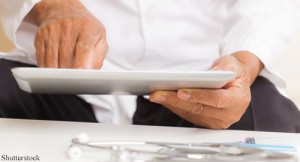 Telemedicine typically uses webcams and computers to bring the provider closer to the patient. Now, new smartphone and tablet apps, such as TouchCare, allow for virtual housecalls.
Telemedicine typically uses webcams and computers to bring the provider closer to the patient. Now, new smartphone and tablet apps, such as TouchCare, allow for virtual housecalls.
“TouchCare is essentially a HIPAA-compliant FaceTime on a schedule,” says Kevin Biese, MD, who is a medical consultant with the company. “We are trying to move past the idea that telemedicine requires big machines you roll into a remote office that only link one health care setting to another. Instead, we bring mobile health to a person in their home through their smartphone or tablet.”
TouchCare is available for most Apple and Android devices. The app itself is free to both the physician and the patient. An upgraded version charges approximately $100 per month per physician to use the app’s enhanced clinical and billing features.
Although the app can be configured on the basis of the practice’s needs, most physicians use it to set and keep appointments. The patient activates the app, then the physician is alerted that the person is waiting and starts the interaction. The app accesses both the webcams and microphones of the mobile device, so users can see and hear each other throughout the session.
Useful for Select Patients
Rheumatologists may find apps useful for select patients. Other telemedicine options bring a patient into a remote office with a presenter who acts as the provider’s eyes, ears and hands. This design means that certain things, such as probing for painful joints and looking at a person’s gait, are easily accomplished. Apps for which the patient is alone make some of these diagnostic procedures more difficult to accomplish.
“Matching an individual patient with the right visit modality is key,” notes John H. Mecchella II, DO, MPH, a rheumatologist and associate medical director of information services at Dartmouth-Hitchcock Medical Center in Lebanon, NH. “For patients [with whom] I have a clear understanding of their disease process and treatment course, I may not need to see them in an office setting. For others, I may want to see them in a more structured setting.”
Adding Efficiency
Apps can add to the efficiency of the system and may allow rheumatologists to see and keep more patients. The early telemedicine systems were put in place because people were not being adequately treated if they lacked the resources, or desire, to make an hours-long trek to a centrally located physician. Apps cut the travel time down to nothing in some cases, which may make a patient more likely to stay in treatment.



